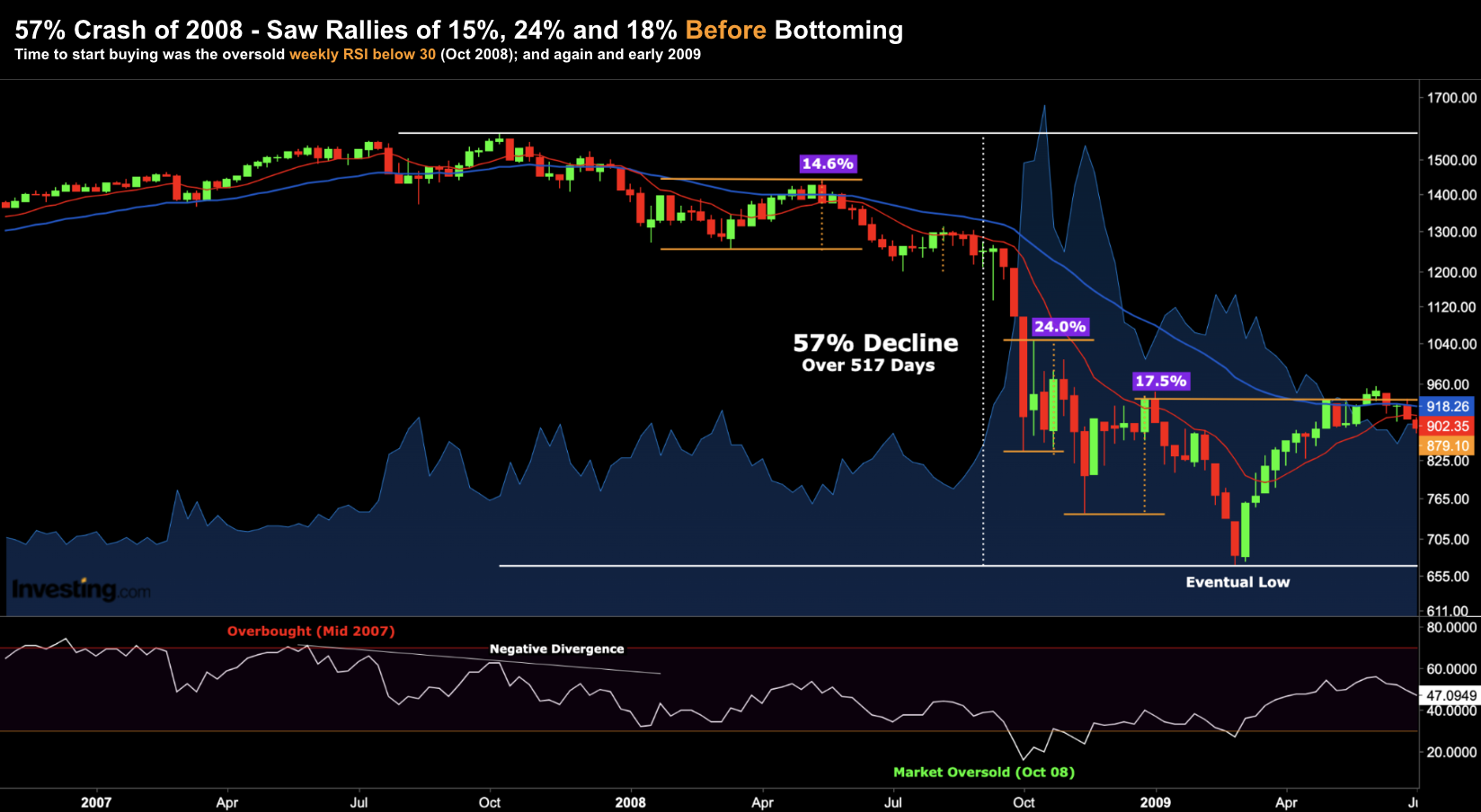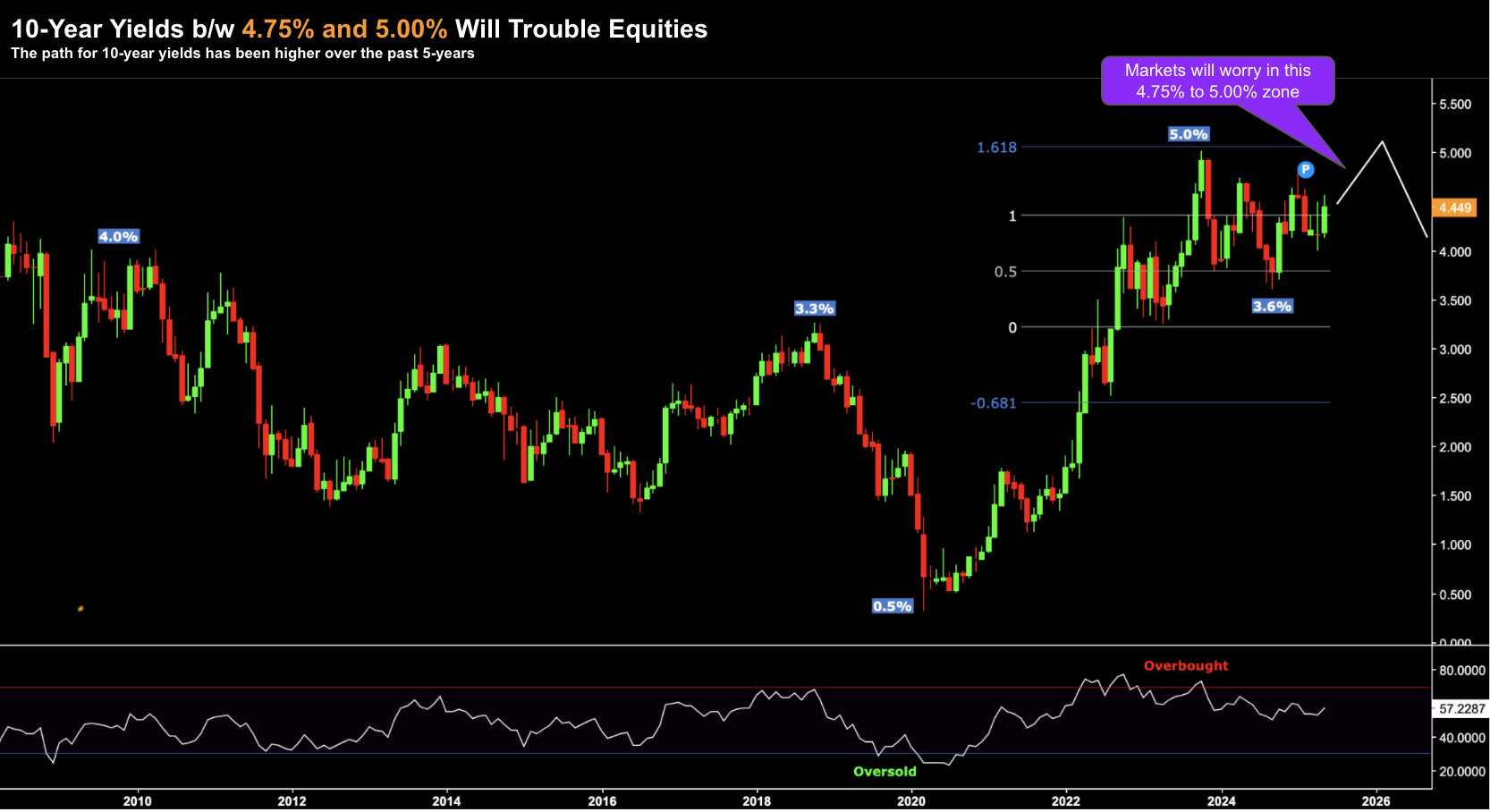Words: 1,734 Time: 8 Minutes
- 84% of S&P 500 companies cite “uncertainty” in Q1 earnings calls
- How much will demand pull forward impact Q3/Q4 earnings?
- It may pay to reduce your exposure at ~22x fwd PE ratio
Factset reported today that S&P 500 companies are highly uncertain for the balance of this year.
Their Document Search tool – which analyses conference call transcripts – reported 381 companies cited the term “uncertainty” during their earnings calls for the first quarter.
This is well above the 10-year average of 179; and more than double the previous quarter.
On a percentage basis, the term has been cited on 84% of the 451 earnings calls since March 15. The last time we saw something similar was during the peak of the COVID pandemic.
And it makes sense…
It’s impossible to dimension what impact tariffs could have over the coming two to three quarters (or more).
This is why most companies have refused to offer any guidance… they can’t.
But what’s almost certain – any impact won’t be positive.
Tariffs are an economic burden – where I believe the cost to both companies and consumers could be as high as $300B (or more).
What’s undecided is who will pick up the bulk of the tab? Someone will be.
Regardless, is this risk fully priced in to markets?
My take is some market participants (mostly retail investors) could be falsely assuming we’re past the worst of the tariff risks – where they feel the downside risk from here is minimal (hence the 20%+ rally).
But first – let’s recap – because this isn’t the first time we’ve seen this movie.
Bear Market Rallies Are Expected
The current rally of ~22% from the recent lows should not come as a huge surprise.
For example, we were deeply oversold on a technical level (the weekly RSI below 30) – where markets will often catch a near-term bid.
Nothing rises (or falls) in a straight line.
But it’s also important to understand that when markets are dislocated (or when things substantially change) – rarely are those problems solved in a matter of a few weeks.
However, when we experience a double-digit percentage rally in such a short space of time – it often given investors the perception of everything being okay (i.e., disaster avoided… phew!)
Rarely this is the case (especially in the absence of any meaningful monetary support).
For example, consider the global financial crisis of 2008.
Markets ultimately gave back 57% from peak to trough (see below).
However during the 517 day pullback – the market saw three rallies of 15%, 24% and 18% before finding the eventual bottom in early 2009.
Whilst not the focus of this post – the time to buy was (a) when the VIX hit (and exceeded) 45; and (b) the weekly RSI fell below 30.
Similarly, the time to reduce exposure was the overbought RSI in mid 2007 – also supported by negative divergence (i.e., fading bullish momentum).
And we saw something similar during the tech crash of 2000.
Markets also lost a little more than ~50% (peak to trough) – and on the way down – saw three rallies of between 15% to 20%
You can read more about why I don’t trust this v-shaped rally here.
Let’s expand on this further… specifically the likely negative impact to second half earnings.
Demand Pulled Forward
Retail investors are excited that cooler heads have prevailed with tariffs.
And applying some common sense is long overdue.
However, we’re still a long way from declaring ‘victory’ over this self-inflicted mess.
A lot of structural damage has been done… most of which cannot be undone.
What’s more – no deal has taken place between China and the US. It’s simply a pause to talk.
Beyond the large uncertainty surrounding tariffs – investors should be paying close attention to rising bond yields.
For example, we saw the 30-year yield push 5.0% today; and the 10-year yield trade back to levels of ~4.50%
And from mine, a 10-year yield in the realm of 4.75% to 5.00% will worry equities (see this post on the lack of equity risk premium investors are receiving)
Here we need to ask why investors are dumping US debt – in turn sending yields higher?
For those less familiar with fixed income – bond yields trade inversely to their price; i.e., when bonds are sold – yields rise and vice versa.
Alternative, are yields rising because investors envisage:
- Concerns with fiscal recklessness from the White House (where investors command greater compensation to own U.S. debt); and/or
- Inflation risks in the pipeline (as a result of tariffs)?
… or potentially both?
But coming back to the tariff risks – and the impact this will have on both demand and supply chains.
To start, we know Chinese tariffs are down to 30% for now (from ’embargo’ like levels of 145%).
We also know the UK reached a “great deal” (Trump’s language) of 10% – despite running a trade surplus with the US (i.e., where the UK buy more US goods than they sell to the US – but were still penalized with 10%)
Based on the UK deal – global average tariffs are likely to average somewhere between 10% and 20% (at a rough guess). They could be higher.
If that proves accurate (see this post) – even 10% will prove material.
For example, I offered back-of-the-envelope math to try and dimension the (coming) economic burden based on this scenario (obviously anything greater than 10% will be significantly worse).
Repeating some of my (high-level) logic:
- US companies paid ~$400B in income taxes last year (maybe slightly more).
- The US imported goods last year in the realm of $3.8 Trillion.
- If we assume that Trump “only” imposes a baseline 10% tariff on all countries – that’s about $380B in tariffs; which is an approx. $300B incremental tax to the existing average U.S. tariff of ~2%
- The total “economic burden” is in the realm of $400B + $300B = $700B
And whilst this is a very complex thing to model (i.e., where consumption taxes are not the same as income taxes) – my general point is cost increases are coming.
That is, there will be an economic burden to bear.
But for who?
For example, if it’s not companies absorbing the incremental ~$300B in tariff costs – it will be consumers.
But let’s explore something else which the market may not be fully calibrating.
The U.S. economy is now 26.3 % of world’s total GDP – at ~$29.2 Trillion.
This represents a significant increase from 21.1% share of global GDP in 2011 (as an aside, just how is the US “losing” over the past 14 years – as Trump believes?)
In terms of U.S. imports – they surged some 41% in Q1.
As I wrote at the time – this was a significant factor contributing to a 0.3% contraction in U.S. GDP during the same period—the first quarterly decline in three years (i.e., in the absence of this record amount of imports – GDP would have been positive).
Sectors such as pharmaceuticals, metals, and consumer goods all sought to effectively stockpile inventory before tariffs took effect.
That is a massive pull forward of inventory – something we also saw during COVID.
Consider Apple:
They reportedly airlifted approximately 600 tons of iPhones—around 1.5 million units—from India to the U.S. in late March 2025 to preempt the impact of impending tariffs
These shipments were executed via five to six chartered cargo flights over a three-day period, aiming to stockpile inventory.
By accelerating shipments, Apple was doing all it could to avoid immediate price increases and supply disruptions.
By way of comparison – during COVID – total US imports saw an 88% increase in Q3 2020 because of supply chain issues.
With respect to tariffs – they were proactive measures. However with COVID – shipments were reactive.
But in both cases, we are seeing massive pull forward.
This brings us to Walmart’s recent conference call – where they said “we can’t adjust to this” – doing what they can to try and absorb (some) of the price increases.
For example, during the Q1 2025 earnings call, both CEO Doug McMillon and CFO John David Rainey emphasized that the scale and speed of the tariff increases are unprecedented and exceed what any retailer can absorb without passing costs on to consumers.
So far this year, we have seen total U.S. imports:
- Surge during Q1 (i.e., front-running tariff risks);
- Collapse in April (with “Liberation Day” ); and
- Potentially surge again given the 90-day pause.
This raises a couple of questions:
How are companies going to manage the pull forward? And how is this going to impact earnings in the second half?
Earnings Expectations are Too High
Given all the above – my feeling is S&P 500 earnings expectations for Q3/Q4 are still far too high (where the full year is around $275 per share)
For now, the market is optimistic earnings targets will be met.
For example, Q1 earnings beat expectations however there was very little tariff impact on those numbers.
If we look ahead, I can’t help but think the market is pricing in very little:
- Tariff impact;
- Inflation impact;
- Government spend impact;
- Bond yield impact; and
- Consumer behavior impact.
In other words, they still believe that earnings will grow in the realm of 10% to 12% YoY (largely unchanged).
For what it’s worth, the price action (and sentiment) on the S&P 500 is somewhat similar to Q4 2021.
During this time I took measures to lower my risk coming into 2022 (which meant I avoided the 19% decline in stocks that year)
However, retail investors chased stocks higher wanting to believe that “everything is fine” – perhaps suffering from FOMO or performance anxiety.
Be fearful when others are greedy; and be greedy when they are fearful.
And whilst I recognize the market could rally further on momentum (e.g., 5-7%) — the risk of downside now handily outweighs any further upside reward.
Putting it All Together
Hopefully you caught some of this 20% bounce the past few weeks…
Below is my year-to-date performance... up around 4.0% and slightly higher than the Index.
I added some exposure to higher quality names when the Index traded near 4800 – which allowed me to capture the rebound.
However, today I’m exercising caution.
I’m taking two steps:
- First, I’m not adding to my market exposure;
- Second, lowering my exposure to names where tariffs will have an outsized impact.
My feeling is the market (mostly retail investors) are potentially underestimating the (coming) negative impact of tariffs, inflation, reduced government spend and higher bond yields.
Each of the above will likely negatively impact both consumer behavior and earnings growth in the second half.
If correct, this implies the market is over-valued at ~22x forward earnings (where 5,963 / $275 = 21.7x).
Let’s see how we go…



